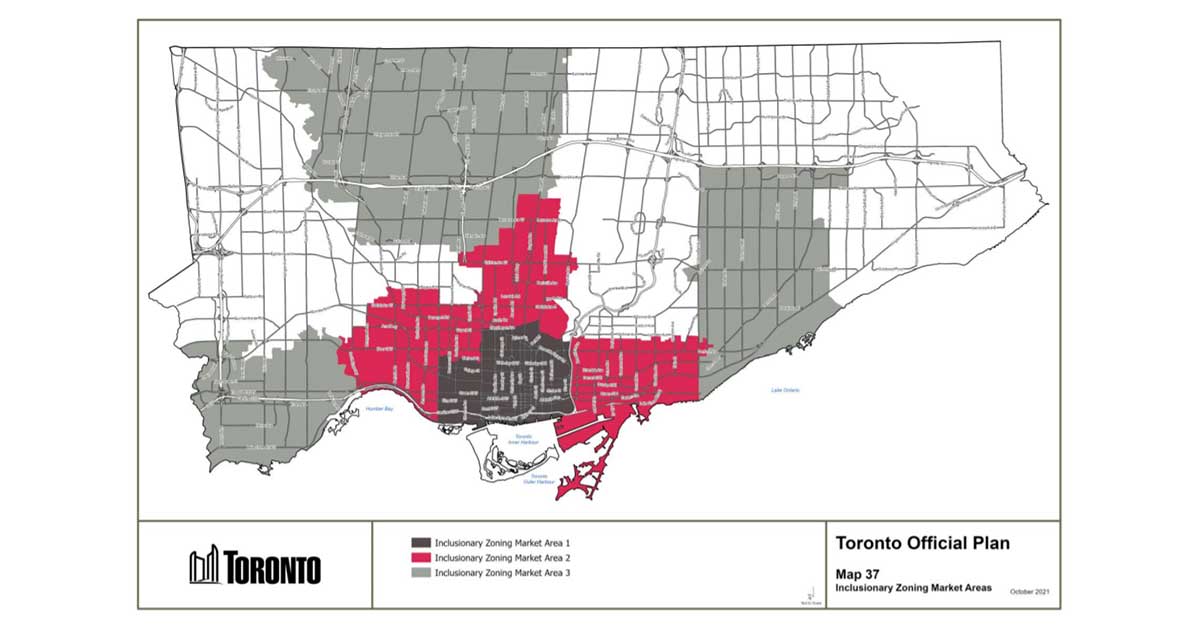On November 9, 2021 the City of Toronto approved Official Plan and Zoning Bylaw amendments as well as draft Implementation Guidelines introducing Inclusionary Zoning requirements. These requirements will make Inclusionary Zoning mandatory for new developments that meet certain criteria in approved Protected Major Transit Stations Areas (PMTSA) to include affordable rental and ownership housing units beginning in late 2022. The city also made changes to definitions related to affordability in the Official Plan.
The new planning tools include:
- City of Toronto Official Plan Amendment 557
- City of Toronto Zoning By-law Amendment
- Implementation Guidelines (currently in draft, for consultation through the first half of 2022)
Authority and legal framework
- The Planning Act enables inclusionary zoning as a planning tool in official plans under s. 16(4)-(13) and through by-laws in s. 35.2
- O. Reg. 232/18 prescribes requirements for a municipality’s Inclusionary Zoning approach
- The Planning Act allows for inclusionary zoning to be implemented within approved PMTSAs (s. 16(5))
- The Planning Act permits municipalities to delineate PMTSAs (s. 16(15, 16))
- The Growth Plan requires upper- and single-tier municipalities to delineate MTSAs (Policy 2.2.4.2) by July 1, 2022 (the Ministry-directed deadline for all municipalities to complete their conformity exercises, known as Municipal Comprehensive Reviews or MCRs)
- It is the responsibility and jurisdiction of a municipality to determine which MTSAs it identifies as PMTSAs, but PMTSAs require Ministry approval.
- Identifying a PMTSA allows for inclusionary zoning to be implemented and used by municipalities as an affordable housing planning tool.
Geographic application in Toronto
Inclusionary Zoning can only apply within delineated and provincially approved PMTSAs. Map 37 of the Official Plan (reproduced below) outlines three Inclusionary Zoning Market Areas that assist with identifying required rates of affordable housing, which are further discussed below. According to studies conducted by the city and its consultants, these are areas of the city experiencing increases in new housing supply and rental prices.
The Planning Act requires the assessment report to be reviewed at least every five years to evaluate if Inclusionary Zoning requirements should be adjusted or applied to new areas. As Inclusionary Zoning is new policy, the city is committed to conducting a review of the assessment report after three years, although this commitment is not enshrined in the OPA. City Council also directed a review of the market impacts of inclusionary zoning one year after implementation, which may result in further amendments to address incentives, phase-in and/or set aside rates, development size thresholds and other changes to ensure market stability and production of affordable units.

Affordability
The city has amended definitions related to affordability in the Official Plan.
- ‘Affordable rental housing and affordable rents’
- ‘Affordable ownership housing and affordable ownership prices’
Who does this target?
The Official Plan targets households making between $32,486 and $91,611 with ownership and rent prices set so that a household does not spend more than 30 per cent of before-tax income toward housing costs.
Changes from Ministry
Through consultation with The Ministry of Municipal Affairs and Housing, City Staff made changes to the proposed Inclusionary Zoning framework, including clarifying: (1) the implementation of inclusionary zoning in PMTSAs, (2) procedures for ensuring the units remain affordable (monitoring procedures), and (3) net proceeds for the sale of an affordable unit, and (4) transition provisions.
(1) Applicability to PMTSAs
Ultimately, despite some back and forth with the city, Inclusionary Zoning will only be implemented within a PMTSA that is also located within an Inclusionary Zoning market area. The city’s Official Plan policy has been strengthened and clarity added, consistent with the requirements that already exist in the Planning Act in this regard. It is finally made very clear that Inclusionary Zoning will only take effect in an approved PMTSA.
(2) How to maintain affordability
To ensure the affordable units secured through inclusionary zoning remain affordable during the affordability period, owners will be required to enter into agreements registered on title which will include requirements for ongoing administration, reporting, and monitoring of the affordable units. In accordance with the Planning Act, Council will adopt a procedure for administration and monitoring outlined in the Implementation Guidelines that will address elements including: administration of affordable rental units and affordable ownership units (including access plan requirements, household eligibility, income eligibility, marketing, screening and selection process, rent increases, resale process and price increases) and regular reporting requirements.
(3) Net proceeds
For development or redevelopment subject to an Inclusionary Zoning By-law, one or more agreements that are registered on title to the lands shall be entered into with the City securing 50 per cent of the net proceeds of the sale of a unit sold at market price during the 99-year affordability period, to be reinvested in affordable housing.
(4) Transition effective date
The Zoning By-law Amendment for Inclusionary Zoning now explicitly references the transition date as the later of September 18, 2022 or Notice of Approval of a PMTSA by the Minister. Therefore, should the Minister not approve a PMTSA in an Inclusionary Zoning Market Area by September 18, 2022, inclusionary zoning requirements will not apply. This was the province’s original intension and is now being made explicitly clear at city level.
Transition provisions
The updated Inclusionary Zoning policies provide for a transition date of September 18, 2022, whereas the previous draft Inclusionary Zoning policies set out a transition date of January 1, 2022.
Section 600.30.15 of the Inclusionary Zoning, Zoning By-law Amendment establishes transition policies that must be followed in order for development applications to be exempt:
“600.30.15.1 Transition: Zoning By-law Amendment and Site Plan Applications
(1) Zoning By-law Amendment and Site Plan Applications
Nothing in Section 600.30 will prevent the erection or use of a building or structure, for which:
(A) Complete applications for a zoning by-law amendment and site plan approval were filed on or prior to the later of September 18, 2022 or notice of approval of a "Protected Major Transit Station Area" by the Minister pursuant to the Planning Act;
(B) A zoning by-law amendment came into force prior to the passing of a Community Benefits Charge by-law and an agreement was executed in accordance with Section 37 of the Planning Act on or prior to the later of September 18, 2022 or notice of approval of a "Protected Major Transit Station Area" by the Minister pursuant to the Planning Act; or
(C) A complete application for site plan approval was filed on or prior to the later of September 18, 2022 or notice of approval of a "Protected Major Transit Station Area" by the Minister pursuant to the Planning Act.
600.30.15.2 Transition: Minor Variance Applications
(1) Minor Variance Applications
Nothing in in Section 600.30 will prevent the erection or use of a building or structure, for which:
(A) Complete applications for a zoning by-law amendment and site plan approval were filed on or prior to the later of September 18, 2022 or notice of approval of a "Protected Major Transit Station Area" by the Minister pursuant to the Planning Act;
(B) A zoning by-law amendment came into force prior to the passing of a Community Benefits Charge by-law and an agreement was executed in accordance with Section 37 of the Planning Act on or prior to the later of September 18, 2022 or notice of approval of a "Protected Major Transit Station Area" by the Minister pursuant to the Planning Act; or (C) A complete application for site plan approval was filed on or prior to the later of September 18, 2022 or notice of approval of a "Protected Major Transit Station Area" by the Minister pursuant to the Planning Act.
600.300.15.3 Transition: Building Permit Applications
(1) Building Permit Applications
Nothing in Section 600.30 will prevent the erection or use of a building or structure for which:
(A) An application for a building permit was filed on or prior to the later of September 18, 2022 or notice of approval of a "Protected Major Transit Station Area" by the Minister pursuant to the Planning Act; or
(B) An application for a building permit was filed after September 18, 2022 or notice of approval of a "Protected Major Transit Station Area" by the Minister pursuant to the Planning Act, in respect of a zoning by-law amendment or site plan referred to in regulation 600.30.15.1(1) or a minor variance referred to in regulation 600.30.15.2(1).
Quantity (set aside rate) of affordable housing required
The quantity of affordable housing that is required to be provided is dependent on which ‘Inclusionary Zoning Market Area’ the development is located in.
The set aside rates of affordable housing required to be provided as of 2022 in condominium development (as opposed to purpose-built rental) are as follows:
- Inclusionary Zoning Market Area 1
- A minimum of 7 per cent of the total GFA for residential uses must be provided as affordable rental housing units; or
- A minimum of 10 per cent of the total GFA for residential uses must be provided as affordable ownership housing units.
- Inclusionary Zoning Market Area 2
- A minimum of 6 per cent of the total GFA for residential uses must be provided as affordable rental housing units; or
- A minimum of 8 per cent of the total GFA for residential uses must be provided as affordable ownership housing units.
- Inclusionary Zoning Market Area 3
- A minimum of 5 per cent of the total GFA for residential uses must be provided as affordable rental housing units; or
- A minimum of 7 per cent of the total GFA for residential uses must be provided as affordable ownership housing units.
The above is effective September 18, 2022 to December 31, 2024. Rates increase annually effective January 1, 2025 in order to achieve 8-22 per cent affordable housing by 2030. This phase-in should allow time for land values to adjust and the amount of affordable housing to increase incrementally.
Exemptions from Inclusionary Zoning
A purpose-built rental housing building or an ownership housing building is exempt from Inclusionary Zoning if it contains fewer than 100 dwelling units and less than 8,000m2 of residential gross floor area. Purpose-built rental will have no required minimum units at the outset in 2022; a phased-in minimum requirement will commence in 2026, at a “modest” rate, less than for condominium development (i.e. 0-5 per cent)
Dwelling units that are secured as rental replacement units (pursuant to Section 3.2.1.6 of the Toronto official Plan) are not included in the total number of dwelling units or new dwelling units.
Other exemptions apply to student residences, retirement homes, nursing homes, or residential care homes.
No appeals except by Minister
The Planning Act provides that only the Minister may appeal the Official Plan policies and associated Zoning By-law implementing inclusionary zoning to the Ontario Land Tribunal.
BLG’s Municipal & Land Use Planning lawyers are available to discuss how these amendments may impact your future development projects. Reach out to any of the key contacts below for assistance.





